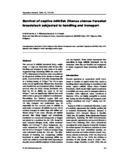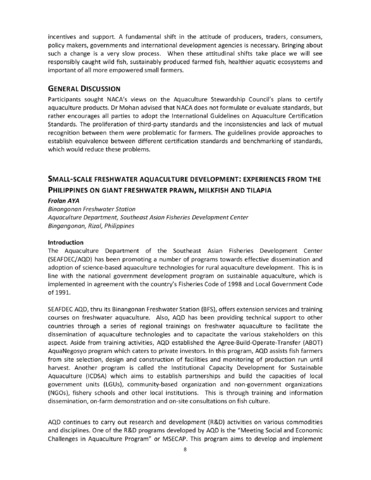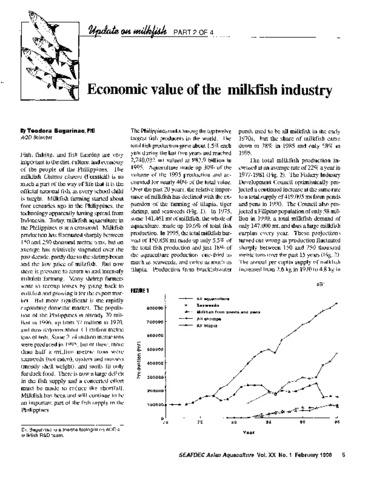Survival of captive milkfish Chanos chanos Forsskal broodstock subjected to handling and transport

View/Open
Date
2000Page views
382Metadata
Show full item recordCited times in Scopus
8
CITATIONS
8
Total citations
1
Recent citation
0.7
Field Citation Ratio
n/a
Relative Citation Ratio
21 readers on Mendeley
Share
Abstract
The survival of milkfish broodstock (body weight range 1–11 kg) was determined until 30 days after handling and transport in open tanks or in sealed oxygenated bags containing chilled sea water (20–25 °C). Maintenance of cool sea water was achieved by the gradual addition of ice chunks or frozen gel packs. A survival rate of 50% after transporting fish at a loading density of 45 kg m−3 for 4 h in open tanks was not significantly different from those that were handled but not transported (86%). Similarly, survival rates (67–83%) among broodstock confined for 8 h in chilled sea water at 40 and 60 kg m−3 were not significantly different from each other or from a group not subjected to confinement. Nevertheless, low dissolved oxygen (DO) and accumulation of total ammonia–nitrogen beginning 1 h after transport and confinement may be responsible for low survival rates of milkfish in open tanks. In contrast, all milkfish survived 10 h of overland transport in sealed bags with chilled and diluted (28 g L−1) sea water. Likewise, all milkfish survived after being bagged and immediately transferred to a communal rearing tank, or bagged and placed in a styrofoam box for 10 h. Except for total ammonia–nitrogen levels, which increased slightly (0.7–0.8 mg L−1) above background, seawater temperature (20–24 °C), salinity (28 g L−1) and DO (6 to > 20 mg mL−1) titres in transport bags were maintained during the 10-h test. The effectiveness of handling and transporting milkfish broodstock in sealed bags containing chilled sea water was verified in actual field trials. Spawning of sexually mature milkfish subjected to these stressors was not impaired. These results demonstrate that mortalities of large milkfish broodstock can be minimized when fish are handled and transported in sealed oxygenated bags containing chilled sea water.
Suggested Citation
Garcia, L. M., Hilomen-Garcia, G. V., & Emata, A. C. (2000). Survival of captive milkfish Chanos chanos Forsskal broodstock subjected to handling and transport. Aquaculture Research , 31(7), 575-583. https://doi.org/10.1046/j.1365-2109.2000.00475.x
Subject
Taxonomic term
Collections
- AQD Journal Articles [1248]
Related items
Showing items related by title, author, creator and subject.
-
Small-scale freshwater aquaculture development: Experiences from the Philippines on giant freshwater prawn, milkfish and tilapia
Aya, Frolan (Japan International Cooperation Agency, 2013-12)The Aquaculture Department of the Southeast Asian Fisheries Development Center (SEAFDEC/AQD) has been promoting a number of programs towards effective dissemination and adoption of science-based aquaculture technologies ... -
Economic value of the milkfish industry
Bagarinao, Teodora (Aquaculture Department, Southeast Asian Fisheries Development Center, 1998)A brief description is given of the milkfish (Chanos chanos) farming industry in the Philippines. Over the past 20 years, the relative importance of milkfish has declined with the expansion of tilapia, tiger shrimp and ... -
Milkfish ponds from mangroves
Bagarinao, Teodora (Aquaculture Department, Southeast Asian Fisheries Development Center, 1998)



